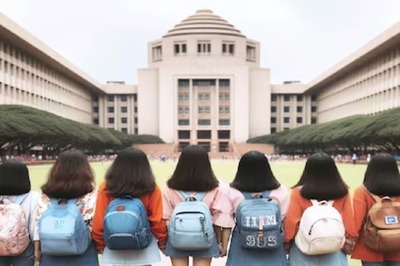
views
The border district of North 24 Parganas, West Bengal has been one of India’s prominent trafficking hubs. Porous borders with Bangladesh have made this district a hotspot for trafficking girls and women. The devastating effect of the conjunction of two disasters, COVID-19 and Amphan, have made the risk of trafficking now higher than ever. More than 80,000 livelihoods have been destroyed and local communities are desperate to earn. Traffickers are using this vulnerability to target families in dire situations and exploit them.
The sudden and alarming increase in child marriages in the district is a cause for concern. In Hingalgunj block alone, as many as 12 child marriages have taken place within a month of ‘unlocking’. What we are hearing is that marriage offers are being made to particularly vulnerable families and that these are in fact just a ruse for trafficking. With schools closed and all sources of income dried up, families are having to pick between two shattering evils. Thet have admitted to marrying off their children despite knowing the risks. The sense of hopelessness is high, and as Malati, a resident of Sandeshkhali, puts it, “If my daughter stays here, she will surely die of starvation. At least with the marriage, there is some glimpse of hope for a better life.”
In most of these marriages, young girls endure exploitation, abuse, marital rape, and confinement by their husband and in-laws. Along with child marriage trafficking, labour trafficking is rampant. An article published this month in Ei Samay, a local Bengali newspaper, highlights how fraudulent recruiters are actively targeting and luring young women with promises of a good job. With identity documents missing or taken away and the consequent inaccessibility of social services, the risk of being trafficked is multiplied exponentially.
Children of seasonal migrant workers are the most vulnerable group, as they face barriers in accessing education along with isolation in new places. Young boys and girls are subjected to unpaid exploitative labour practices.
This month alone, 17 women have been rescued from Bihar by the West Bengal Police and brought back to North and South 24 Parganas. Some had been sold off to dance groups that were actually prostitution rackets while others were bonded labourers in factories.
Debayan, working in Minakhan, showed us Facebook job postings circulating in the neighbourhood and mentioned:
“These jobs are in a formal office setting — receptionist, call centre which don’t require too much education. A 10th pass student can do it. These jobs offer Rs. 11,000–12,000/- and seem lucrative. A corporate job in Kolkata, when you don’t have much education, is a dream. The official logo is also there in the ads and looks very genuine!”
Interviews for these jobs are conducted through third-party consultancies/hiring agencies. Photographs, copies of identity documents, and around 1,000 rupees are taken from each candidate under the guise of an application process. After submitting details, the candidates register for training that cost around 5,000 rupees under the impression that the process will confirm their position in a good company with a steady salary.
In the process, individuals are made to sign on documents without realising they are not only being scammed for the money they invested, but they’ve also just legitimised their own trafficking.
An emerging channel for trafficking that was until recent times only an afterthought for governments and activists but has assumed greater importance during the lockdown is the threat of digital platforms being misused by traffickers to lure adolescents into trafficking.
Trafficking in rural Bengal shows a disturbing trend: the Internet and Mobile Authorities Report, 2019 has recorded that 14% of rural internet users are between the ages of 5 and 11. Aangan’s primary research shows that digital platforms are emerging as the biggest medium of trafficking children.
Digital Platforms as a Medium for Trafficking
A small study conducted by Aangan’s community child protection volunteers in North 24 Parganas revealed that children voluntarily took up jobs to buy smartphones. In fact, accessing a smartphone was the most prevalent driver for child labour. Decreasing cost of smartphones, cheaper internet plans, and smartphones becoming a class symbol amongst rural youth are factors that have contributed to the mammoth internet penetration across rural areas. However, the divide between internet usage and digital awareness remains to be bridged.
The COVID-19 pandemic has seen unprecedented social and economic disruption, causing far-reaching psycho-social impacts. The lockdown has not only brought huge anxiety and uncertainty about future times but a colossal sense of loneliness and isolation. CNN News18 reported a 40% hike in internet traffic in India during the lockdown, while Business Standard reported that 61% of the rural sector uses the internet every day with a significant amount of time dedicated to social media and chatting — an active hub for child sexual predators. Community volunteer, Archita, informed us about Facebook and WhatsApp applications being used as methods to impersonate and groom children into sending sexually explicit, obscene content leading to child pornography. Another volunteer, Bijoya narrated,
“A 14-year-old girl, Krishna from Hasnabad, had an admirer who regularly communicated with her over WhatsApp and manipulated her to make lewd videos. Later he morphed one of her videos and circulated it across the entire village. Krishna was taken out of school and eventually became a child bride in a distant village.”
In addition, video applications like Musically have been supreme in exposing children to sexual predators due to lack of strict regulations for strangers approaching them.
Bratya, a young boy from Katakhali village, informed us about mobile recharge shops being used as points of pimping contacts of young girls to adult males. These numbers were used to call families under the pretext of arranged marriages, translating to trafficking.
It doesn’t help that child protection systems are not aware of this emerging risk and are therefore ill-equipped with the resources needed to address cyber-crimes. Moreover, legislative gaps and failure of systems to acknowledge cyber harm in rural India as a relevant issue has increased the risk.
Solutions
Governments across the world need to develop holistic solutions especially with a larger focus on prevention to address trafficking at its roots. Raising awareness of the dangers of trafficking amongst vulnerable children has saved millions of lives from being trafficked.
However, for a preventative model to be successful, it is important for local governments to work in collaboration with communities to develop a system that is actively owned and operated by community members and stakeholders. At the same time, it is also imperative for child protection systems to stay informed about contemporary modes of trafficking and equip themselves accordingly.
A preventative model adopted by Aangan showed a 56% increase in safety from harms like sex trafficking and labour trafficking amongst adolescent girls.
A parallel increased interface between police systems and community members increased awareness about legislation and access to social services. Accountability by government authorities to track migrating families improved documentation, decreased family separation, and has been instrumental in tracking down traffickers. Going forward increased social protection schemes for prevention and response to child protection shall be significant in bringing systemic changes.
*All names have been changed to maintain confidentiality
Soumashree Sen works as a Communications & Advocacy Associate at Aangan, a nonprofit committed to preventing child harm in India. Prior to this, she has worked with Voluntary Services Overseas, UK to improve access to healthcare amongst women and adolescents in Jharkhand.




















Comments
0 comment